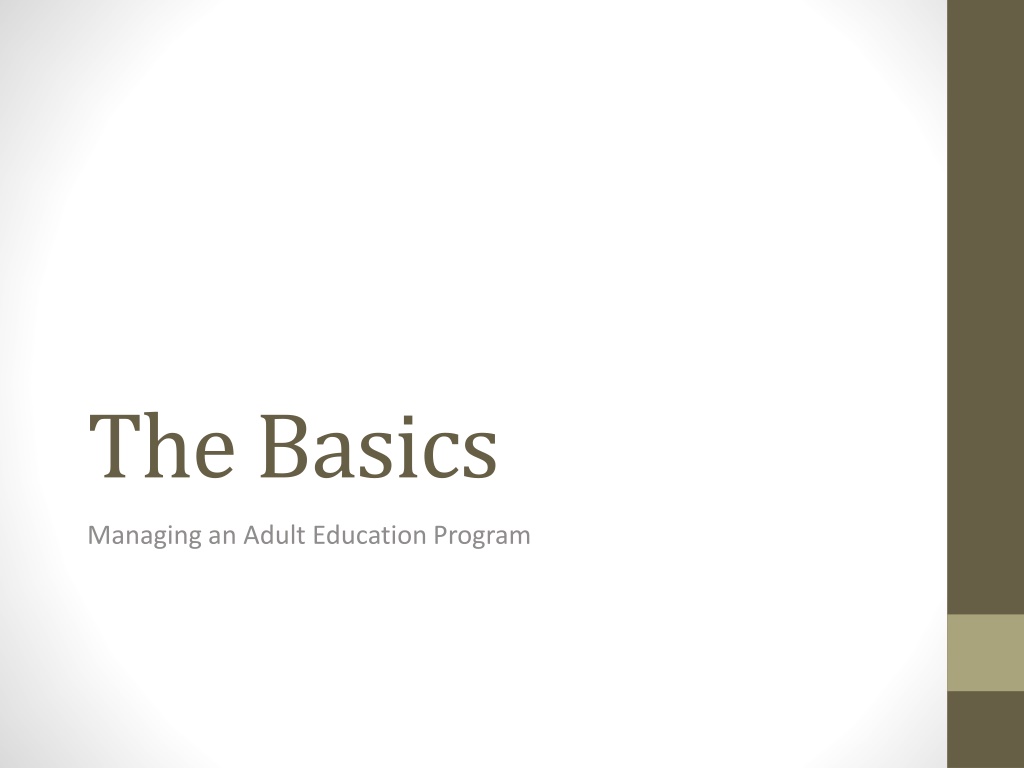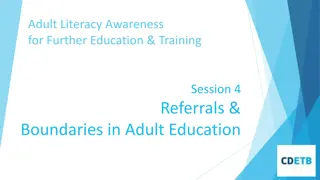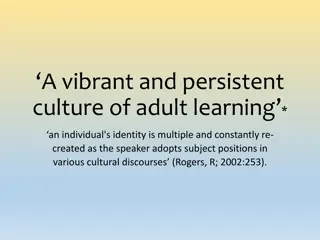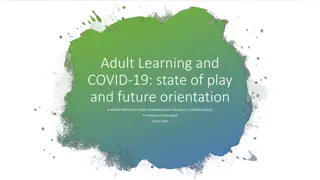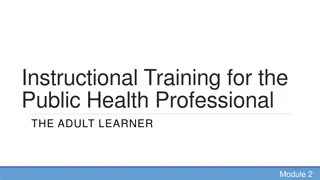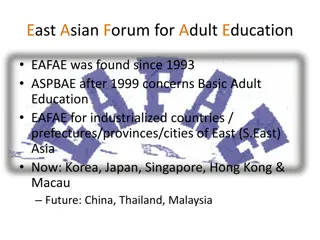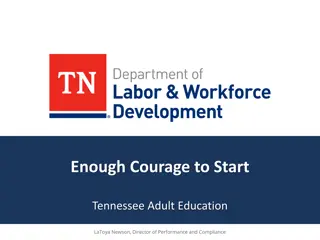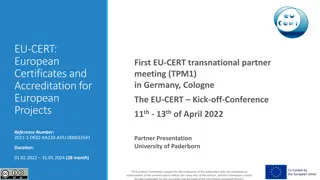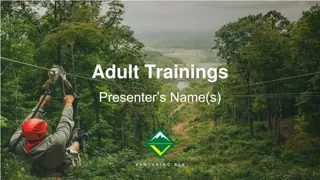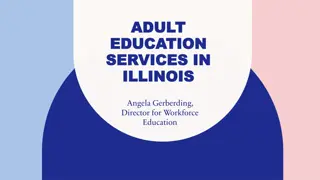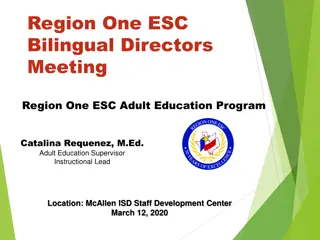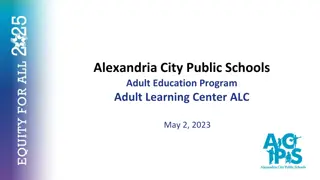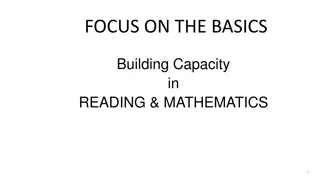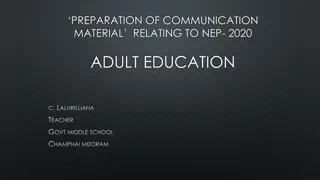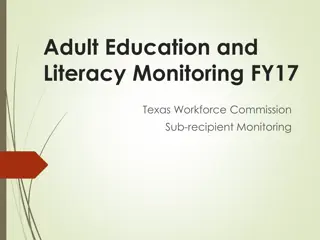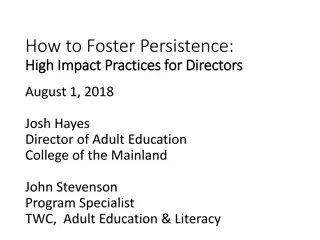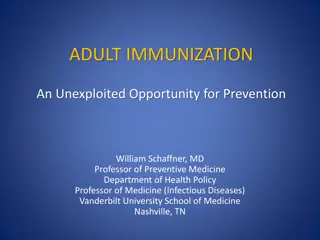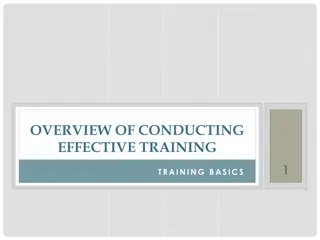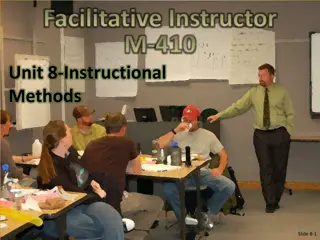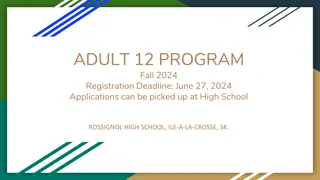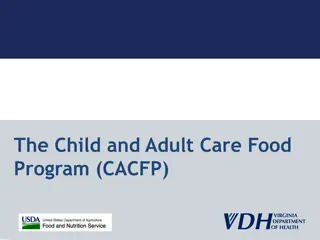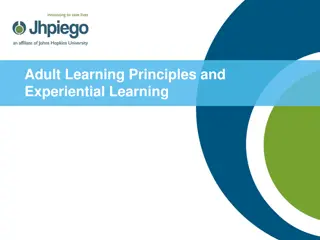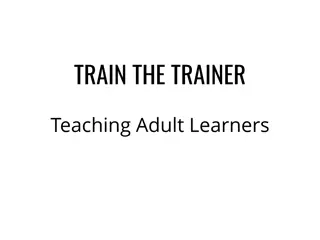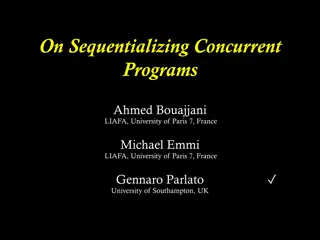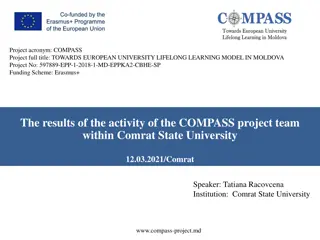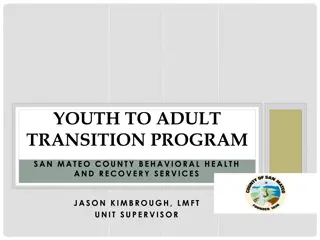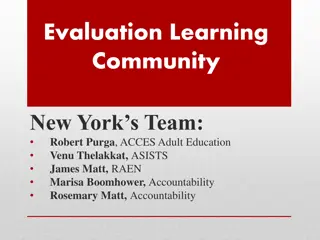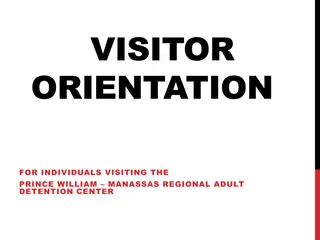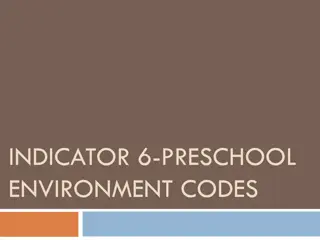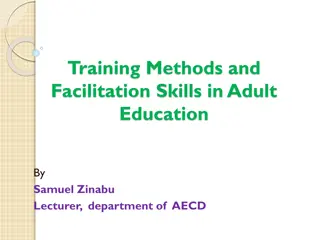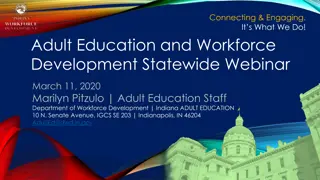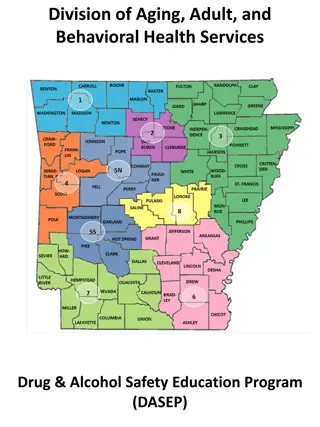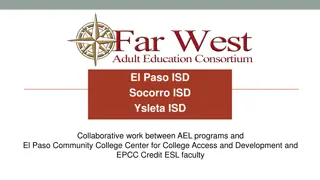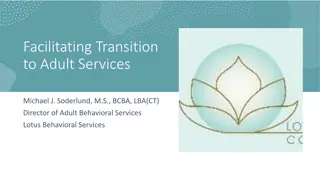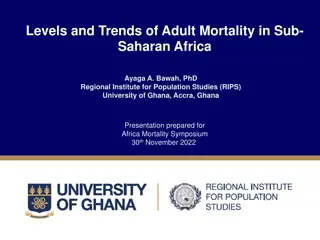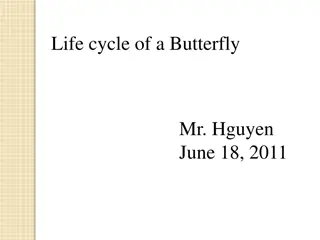Effective Management of Adult Education Programs
Managing a successful adult education program requires attention to four core elements: Team, Compliance, Communication, and Evaluation. Key roles such as Performance Accountability Lead, Quality Assurance Lead, and Career Navigator play crucial parts in ensuring the program's quality and effectiveness. Quotes from industry leaders highlight the importance of hiring, developing, and supporting people in educational settings.
Download Presentation

Please find below an Image/Link to download the presentation.
The content on the website is provided AS IS for your information and personal use only. It may not be sold, licensed, or shared on other websites without obtaining consent from the author. Download presentation by click this link. If you encounter any issues during the download, it is possible that the publisher has removed the file from their server.
E N D
Presentation Transcript
The Basics Managing an Adult Education Program
Question What are four core elements to managing a successful adult education program? Discussion: 5-10 minutes
Four Core Components Team Compliance Communicate Evaluation
Quotes I am convinced that nothing we do is more important than hiring and developing people. At the end of the day you bet on people, not on strategies. - Lawrence Bossidy, Former COO of General Electronics "Never hire someone who knows less than you do about what he's hired to do."-Malcolm Forbes
Team Team Compliance Evaluation Communicate
Team STAFF RESPONSIBILITIES
Performance Accountability Lead Objective: Responsible for ensuring the program meets the established standards of quality including reliability, usability and consistent practice to improve or maintain outstanding performance. This person/team should: Ensure that data is entered timely and accurately Understand all performance obligations Understand what the data is telling them at the provider, site, and instructor levels Communicate specific data consistently and with expected follow-up to appropriate team members/staff Inform Director of concerns in retention, attrition and educational functioning level gains and offer strategies to improve where needed
Quality Assurance Lead Objective: Responsible for leading audit and observation of work to evaluate compliance with policies and procedures. This position should: Develop SOP s that align to state standards and ensure those SOP s are being followed Conduct regular audit of both student and staff files to ensure compliance with minimum TWC standards in areas of eligibility, assessment, and accurate data entry. Work in tandem with Performance Accountability Lead Handle regulating of Personally Identifiable Information (PII) Provide ongoing technical assistance to all staff in areas of compliance and program improvement or enhancement
Career Navigator Objective: Assist in connecting participants with internal departments and/or community partners in order to complete their career pathway to college and/or employment. This person should: Act as a liaison between the local workforce board, employers, and area colleges/technical training providers to promote and streamline referral and admission processes Create pathways for participants based on structured training initiatives and approved models Facilitate participant achievements through tracking, coordination with instructors and ongoing support services intervention
PD Coordinator Objective: Serves as the point of contact for PD planning, implementation and documentation of all areas of PD within the Grant Recipient. Can not be the Director! Develops customized individual PD plans based on position/role for all grant funded staff in accordance with staff qualification rules ( 805.21) Works closely with TCALL s PD Specialist to strategize, plan and implement ongoing PD that directly relates to the Program s needs in consistent intervals that meet the needs of local staff
Compliance Compliance Team Evaluation Communicate
Compliance INTERNAL MONITORING
Monitoring In general there are three essential components every Program should be monitoring quarterly: Eligibility Is the participant eligible and if they are a special population (TANF, 16-18 yo) do you have required documentation in the file to support entrance? Assessment Do the pre/post assessments meet all requirements as outlined in the TWC Assessment Guide? Data Management Does information in the student file match what is in TEAMS? Meaning, do sign in sheets, assessments, and enrollment forms/ROI match what is in TEAMS?
Monitoring Component Criteria Reference Eligibility General Population 16-18 yo TANF RFP 320-14-10 AEL Letter 01-15, Change 1 Assessment Pre/Post Test : Administered dates, scores, completed in alignment with policy TWC Assessment Guide, Test Publisher s tools Data Management Documentation for: Staff files Student files Local forms PII RFP 320-14-10 (Grant Specific Requirements) TWC Rules 805 TWC Assessment Guide WD letter 13-13
Common Monitor Findings Eligibility Ensure ALL test that are given are entered into TEAMS regardless if gain is made Assessment Data Management Strengthen Eligibility Documentation Process: Lack of proper documentation for 16- 18 year olds and TANF participants. Ensure that PII is secure and protected Ensure that all sign in sheets contain required elements Ensure all students have an ITEC in their file Ensure Orientation Requirements are Met Ensure that data/information in student/staff files matches TEAMS. If hours or PD hours exist in TEAMS there must be documentation in the file Ensure that justification is kept in student file if tested early Strengthen Student Enrollment Process: No eligible baseline prior to entering a student in a class, ROI not signed, local forms must contain all required information Ensure that controls exist for consistent reporting of information
Resources There are many resources, these are the most frequently used: RFP 320-14-10, Section 11-13 TWC Rules: Chapter 802: http://www.twc.state.tx.us/files/twc/rules-chapter-802- integrity-texas-workforce-system-twc.pdf Chapter 805: http://www.twc.state.tx.us/files/twc/rules-chapter-805- adult-education-literacy-twc.pdf TWC Assessment Guide National Reporting System (NRS) Guidelines
Practice Makes Progress How often are you monitoring yourself or your sub- contractors? What tools are you using ? What is the follow-up to potential findings or adverse observations that are determined? Discussion: 5 minutes
Highlight Evaluation in Chart Personnel Compliance Communicate Evaluation
Evaluation STANDARDS
Creating Quality Standards In the midst of chaos, there is also opportunity Sun Tzu, A Arte da Guerra
Evaluation Think of the desired outcomes as what you ultimately want the program to accomplish, the activities as what you will do to get there, and the indicators as the gauge of whether, and to what degree, you are making progress. Source: Rebecca Gajda & Jennifer Jewiss, The University of Vermont
Standards Standards are about Quality Standards should align with your mission, objectives, and organizational leadership, and be implemented consistently across your enterprise. Employees need to buy in to the value of adhering to standards so everyone is pulling in the same direction and reinforcing your brand
Components for Success Hiring staff with the abilities to perform the job functions that enhance program outputs Local trainings and team building exercises Utilize committees that represent all facets of the organization to ensure that quality is controlled throughout the system Don t be afraid to tweak or abandon practices and procedures that do not enhance or promote your intended culture
What do Standards Create? Systems that operate and function in the absence of an expert Creates confidence in staff that they matter in the Big Picture and that their talent is purposefully designed
Evaluating Program Quality Data Detective What is your data telling you? Are students staying in the program? Are they making Gains? Are they attending class regularly? Where do you need more classes? Fewer? Students Create procedures for absentee students that include follow-up/outreach efforts to obtain reasons for lack of attendance. Is it an instructor? A class location/time? Program intensity? Staff Create consistent observation schedules with specific criteria. Have students complete evaluations for instructors at least twice a year. These should be conducted by someone other than the instructor. Review staff level data and assign PD that assist in shrinking the gaps in their capacity
Evaluation STANDARDOPERATING PROCEDURES (SOP S)
Standard Operating Procedures (SOP s) SOP s are about accuracy and consistency within a quality model They assist in creating uniformity within a system that will stand up against changes in staff and/or management
Required SOPs You are required to have SOP s for these areas to help create accurate and consistent operations across all providers (RFP 320-14-10, Section 3.1): Recruitment Intake / Screening Assessment / Placement Orientation Data Management and Documentation
SOPs SOP s should align to information contained in written TWC contract, policy and guidance: RFP 320-14-10 TWC Assessment Guide TWC Rules AEL / WD Letters
Discussion 1.What are the desired outcomes of your program? What are the goals? What are we trying to accomplish within the next month/quarter/year(s)? 2.How will we get there? What activities will enable you to reach our outcomes? 3.What will indicate to you that you are making progress toward the desired outcomes? Discussion: 5 minutes
Communicate Compliance Team Evaluation Communicate
Communication GATEWAY TO SUCCESS
Communicate Effectively Tell them "why" in addition to "what" and "how Ensure that all levels of the organization are getting the same message especially your instructors! Communicate, Communicate and Communicate again use different platforms to get the message out Follow-up the communication with a survey or tool that test the audience to ensure they received the right message
Communicate for Success Create regular scheduled meeting and calls with all staff this is for new or revolving information such as regular performance reviews People want to hear from the top of the food chain! Directors need to deliver over arching changes and expectations first hand. Ensure that you meet individually with key personnel on a regular basis for status updates on their specific duties/purview. Utilize technology to reach outlying areas, but do not use it as the sole means of communication. Staff need face/face time and nothing brings more insight than on-site observations
Discussion What types of communication work best in your organization? How often do you meet with all staff? What follow-up tool do you use to ensure that everyone is on the same page? Discussion: 5 minutes
